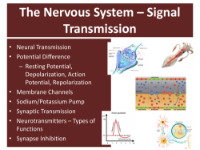2-Minute Neuroscience: Synaptic Transmission
Video
Science
+1
Science
11th Grade - 12th Grade
Premium

N
Neuroscientifically Challenged
Science Resource Description
In my 2-Minute Neuroscience videos I explain neuroscience topics in 2 minutes or less. In this video, I discuss synaptic transmission. I describe the synapse, synaptic cleft, release of neurotransmitter and its interaction with receptors, and the ways neurotransmitter is cleared from the synaptic cleft.
For a more in-depth 10-minute video on synaptic transmission, watch this 10-Minute Neuroscience video: https://youtu.be/k5RafiYXieo
For more neuroscience articles, videos, and a complete neuroscience glossary, check out my website at www.neuroscientificallychallenged.com !
TRANSCRIPT:
Welcome to 2 minute neuroscience, where I simplistically explain neuroscience topics in 2 minutes or less. In this installment I will discuss synaptic transmission.
Most communication between neurons occurs at a specialized structure called a synapse. A synapse is an area where two neurons come close enough to one another that they are able to pass chemical signals from one cell to another. The neurons are not actually connected, but are separated by a microscopically small space called the synaptic cleft. The cleft is less than 40 nanometers wide; by comparison a human hair is about 75,000 nanometers.
The neuron where the signal is initiated is called the presynaptic neuron, while the neuron that receives the signal is called the postsynaptic neuron. In the presynaptic neuron, there are chemical signals called neurotransmitters that are packaged into small sacs called vesicles. Each vesicle can contain thousands of neurotransmitter molecules. When the presynaptic neuron is excited by an electrical signal called an action potential it causes these vesicles to fuse with the presynaptic membrane and release their contents into the synaptic cleft.
Once they are in the synaptic cleft, neurotransmitters interact with receptors on the postsynaptic membrane. They bind to these receptors and can cause an action to occur in the postsynaptic cell as a result. This action may involve increasing the likelihood that the postsynaptic cell will become activated and itself fire an action potential, or decreasing it (inhibition).
Eventually, the neurotransmitter molecules must be cleared from the synaptic cleft. Some of them will simply drift away in a process called diffusion. In some cases, the neurotransmitter is taken back up into the presynaptic neuron in a process called reuptake. Once back inside the presynaptic neuron, the neurotransmitter can be recycled and reused. In other cases, enzymes break down the neurotransmitter within the synapse. Then the component parts can be sent back into the presynaptic neuron to make more neurotransmitter.
REFERENCE:
Purves D, Augustine GJ, Fitzpatrick D, Hall WC, Lamantia AS, McNamara JO, White LE. Neuroscience. 4th ed. Sunderland, MA. Sinauer Associates; 2008.
Explore other content in this scheme
Part of a lesson by Teach with Fergy
Other resources in this lesson

The Schwann Cell and Action Potential
Resource
Science
+1
11th Grade - 12th Grade

2-Minute Neuroscience: Sodium-Potassium Pump
Resource
Science
+1
11th Grade - 12th Grade

Action Potential in the Neuron
Resource
Science
+1
11th Grade - 12th Grade

2-Minute Neuroscience: Neurotransmitter Release
Resource
Science
+1
11th Grade - 12th Grade

The Chemical Mind: Crash Course Psychology #3
Resource
Science
+1
11th Grade - 12th Grade

The Nervous System - Signal Transmission - Exit Ticket
Resource
Science
+1
11th Grade - 12th Grade

The Nervous System - Signal Transmission - Student Lesson Outline
Resource
Science
+1
11th Grade - 12th Grade

The Nervous System - Signal Transmission - Student Presentation
Resource
Science
+1
11th Grade - 12th Grade

The Nervous System - Signal Transmission - Teaching Presentation
Resource
Science
+1
11th Grade - 12th Grade
